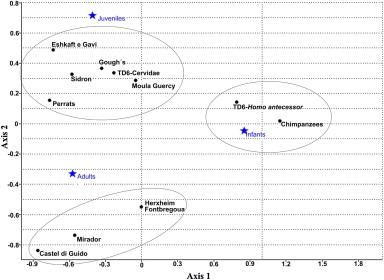The range expansion and imbalance of power hypotheses
Palmira Saladiéa , Rosa Hugueta, Antonio Rodríguez-Hidalgoa, Isabel Cáceresa, Montserrat Esteban-Nadala, Juan Luis Arsuagae, José María Bermúdez de Castrog, Eudald Carbonella
Source - http://www.sciencedirect.com/science/article/pii/S0047248412001406
Abstract
In this paper, we compare cannibalism in chimpanzees, modern humans, and in archaeological cases with cannibalism inferred from evidence from the Early Pleistocene assemblage of level TD6 of Gran Dolina (Sierra de Atapuerca, Spain). The cannibalism documented in level TD6 mainly involves the consumption of infants and other immature individuals. The human induced modifications on Homo antecessor and deer remains suggest that butchering processes were similar for both taxa, and the remains were discarded on the living floor in the same way. This finding implies that a group of hominins that used the Gran Dolina cave periodically hunted and consumed individuals from another group. However, the age distribution of the cannibalized hominins in the TD6 assemblage is not consistent with that from other cases of exo-cannibalism by human/hominin groups. Instead, it is similar to the age profiles seen in cannibalism associated with intergroup aggression in chimpanzees. For this reason, we use an analogy with chimpanzees to propose that the TD6 hominins mounted low-risk attacks on members of other groups to defend access to resources within their own territories and to try and expand their territories at the expense of neighboring groups.

Multiple correspondence analysis of age distribution of the individuals from TD6-Homo antecessor and TD6-cervids, and other prehistoric European cannibalism assemblages including data from Eshkaft-e Gavi and Castell di Guido, which are possible but uncertain cases of cannibalism; data on human/hominins cases from Villa et al. (1986), Boulestin (1999), Defleur et al. (1999), Mariani-Constantini et al. (2001), Andrews and Fernández-Jalvo (2003), Cáceres et al. (2007), Boulestin et al. (2009), Scott and Marean (2009), and Lalueza-Fox et al. (2011). Data on chimpanzee cases from Suzuki (1971), Nishida et al. (1979), Takahata (1985), Newton-Fisher (1999), Watts et al. (2002), Wilson et al. (2004), and Sherrow and Amsler (2007). We get an explanation from 100% taking into account the two dimensions (eigenvalue axis 1 = 75.1, eigenvalue axis 2 = 24.9).